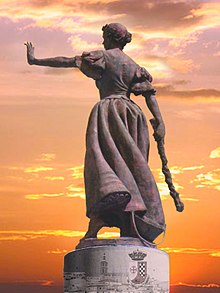Juana Galán

Juana Galán (1787–1812), nicknamed La Galana, was a guerrilla fighter of the Peninsular War (1808–1814) who took to the street to fight against the French cavalry that tried to pass through the town of Valdepeñas. At twenty years old, she was considered the best informed woman of the village, because she worked in a strategic location, the first tavern in the village.
On June 6, 1808, in the Valdepeñas uprising against Napoleon's troops, there was a lack of sufficient men to defend the village, so she encouraged women to go out and fight. Although Galán is usually depicted armed with a baton, one version has it that she smashed in the heads of the soldiers with her cast-iron stew-pan.[1] The other women poured hot water through the windows and boiling hot oil on the road. This battle led, in part, to the French army abandoning the region of La Mancha, which in turn led to the decisive victory for the Spaniards at the Battle of Bailén. This town was granted the title of "Very heroic".
Galán married on May 2, 1810, to Bartolomé Ruiz de Lerma, from Valdepeñas, with whom she had two daughters. She died during her second daughter's birth on September 24, 1812, the same day La Mancha was released by the troops of Napoleon.
See also
References
- ^ Rudorff, Raymond (1974) War to the death: the sieges of Saragossa, 1808-1809, p. 101. Hamilton. At Google Books. Retrieved 25 August 2013.
![]() Media related to Juana Galán at Wikimedia Commons
Media related to Juana Galán at Wikimedia Commons
